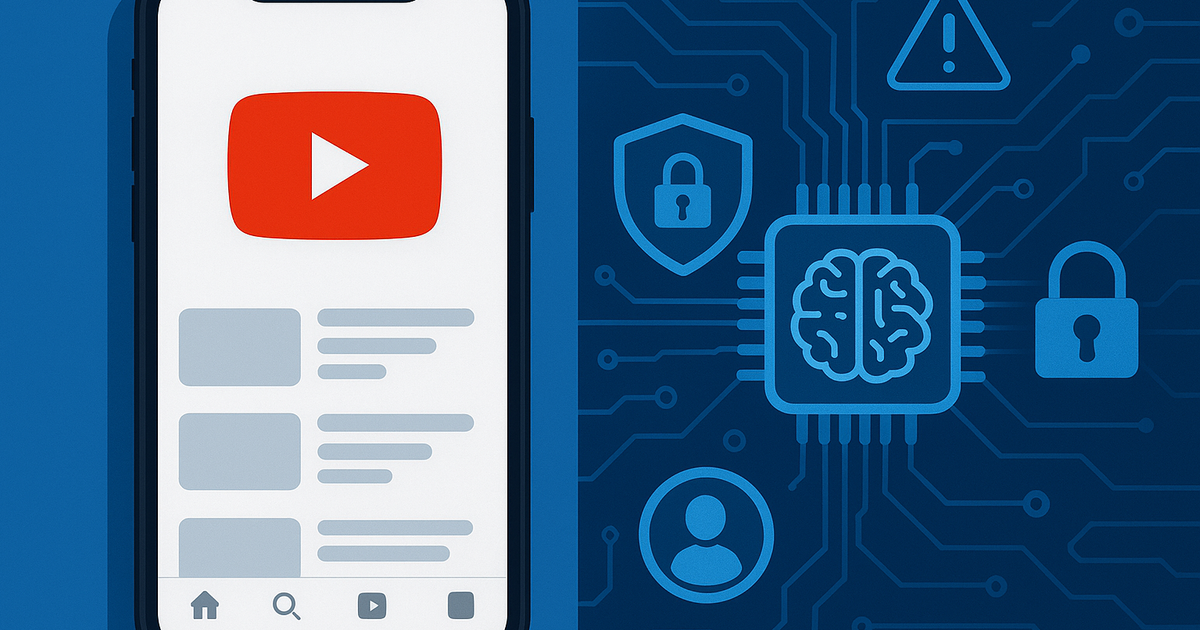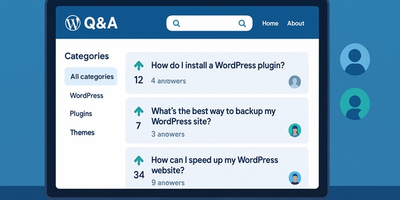YouTube AI Age Verification 2025: What Users Need to Know About the New System Rolling Out in the US
YouTube launches AI age verification in the US. Learn how machine learning estimates your age, privacy concerns, and what happens if you're flagged.
ASALogsAgency Team
Author

YouTube AI Age Verification: The Game-Changing Update That's Sparking Controversy
YouTube began rolling out an 'age-estimation model' in the U.S. that uses AI to restrict access to users determined to be under 18 years old, as part of an effort to prevent kids from accessing inappropriate content online. This significant platform update, which started testing this week, represents one of the most substantial changes to YouTube's user experience in recent years.
The new system has already generated significant discussion among users, with critics raising concerns about privacy as well as access to the platform for users falsely flagged as underage. Understanding how this system works and what it means for your YouTube experience is crucial for all users, regardless of age.
How YouTube's AI Age Verification Actually Works
The Machine Learning Approach
YouTube is extending existing built-in protections to more US teens using machine learning age estimation. Unlike traditional age verification that relies on user-provided information, this new system analyzes viewing patterns and behavior to make educated guesses about user age.
The AI system considers multiple factors including:
- •Viewing History Patterns: The types of content users regularly watch
- •Interaction Behaviors: How users engage with videos, comments, and features
- •Usage Patterns: Time spent on different types of content
- •Platform Navigation: How users move through the YouTube interface
What Triggers Age Restrictions
The system relies on artificial intelligence to differentiate between adults and minors, based on the kinds of videos that they have been watching. When the AI determines a user might be under 18, it automatically applies additional restrictions and safety features.
These restrictions may include:
- •Limited access to certain types of content
- •Enhanced comment moderation
- •Restricted community features
- •Modified recommendation algorithms
- •Additional safety notifications
The Rollout Timeline and Current Status
US Testing Phase
YouTube is trialling AI-powered age verification on a subset of users before rolling it out globally. The initial testing began in August 2025, focusing specifically on US users to refine the system before broader implementation.
Current rollout details:
- •Phase 1: Limited US user testing (August 2025)
- •Scope: Subset of American YouTube users
- •Focus: Algorithm refinement and user feedback collection
- •Timeline: Gradual expansion planned throughout 2025
What Users Are Experiencing
Early reports suggest that users are receiving notifications about enhanced protections being applied to their accounts. Some users report sudden restrictions on content access, while others notice changes in their recommendation feeds and available features.
Privacy Concerns and User Reactions
The Privacy Debate
User privacy concerns have emerged as a primary issue with the new system. The AI's need to analyze viewing patterns and behaviors raises questions about data collection and user profiling.
Key privacy considerations include:
- •Data Analysis Scope: How much user behavior is analyzed
- •Information Storage: What data is retained and for how long
- •Profile Accuracy: Risk of creating detailed user profiles
- •Consent Issues: Limited user control over the age estimation process
User Backlash and Concerns
If YouTube's new AI thinks you're underage, you could be locked out of platform features permanently. This potential for permanent restrictions has sparked significant user concern, particularly among adult users worried about false positives.
Common user complaints include:
- •Fear of permanent account restrictions
- •Lack of transparency in the AI decision-making process
- •Concerns about appealing incorrect age determinations
- •Worry about data privacy and profiling
Impact on Different User Groups
Adult Users: False Positive Concerns
Adult users face the risk of being incorrectly flagged as minors, potentially leading to unnecessary restrictions. This is particularly concerning for:
- •Users who enjoy content that might appeal to younger audiences
- •Adults with varied content consumption patterns
- •Users who share accounts with family members
- •People who primarily watch educational or family-friendly content
Teen Users: Enhanced Protection vs. Access
For actual teenagers, the system aims to provide better protection while maintaining platform access. However, this balance presents challenges:
- •Benefits: Improved safety from inappropriate content and interactions
- •Drawbacks: Potential over-restriction of age-appropriate content
- •Concerns: Reduced platform functionality and social features
Content Creators: Audience Impact
YouTube creators may see significant changes in their audience demographics and engagement patterns as the AI system affects who can access their content.
Global Implications and Future Expansion
International Rollout Considerations
YouTube tests AI age verification in the US. Could India adopt similar age checks for safer content access? The success or failure of the US implementation will likely influence global expansion plans.
Factors affecting international rollout:
- •Regulatory Compliance: Different countries have varying privacy and child safety laws
- •Cultural Differences: Content appropriateness varies across cultures
- •Technical Infrastructure: System requirements may vary by region
- •Legal Frameworks: Age verification requirements differ globally
Industry-Wide Implications
YouTube's move could influence other social media platforms to implement similar AI-driven age verification systems, potentially reshaping how the entire industry approaches teen safety and content restriction.
Technical Details: Understanding the AI System
Machine Learning Algorithm Approach
The age estimation model likely uses supervised learning techniques trained on anonymized user behavior data. The system probably employs:
- •Pattern Recognition: Identifying viewing behavior patterns associated with different age groups
- •Behavioral Analysis: Analyzing interaction patterns and engagement styles
- •Content Correlation: Linking content preferences to demographic data
- •Temporal Analysis: Considering usage patterns over time
Accuracy and Error Rates
While YouTube hasn't published specific accuracy rates, AI age estimation systems typically face challenges with:
- •Edge cases where viewing patterns don't match typical age demographics
- •Users with diverse content interests
- •Shared accounts or family devices
- •Regional and cultural variations in content consumption
What Users Can Do: Options and Workarounds
If You're Incorrectly Flagged
Users who believe they've been incorrectly identified as minors have several options:
- Appeal Process: YouTube likely provides mechanisms to contest age determinations
- Manual Verification: Traditional age verification methods may remain available
- Account Review: Request human review of the AI decision
- Documentation: Provide official age verification documents
Protecting Your Privacy
Users concerned about privacy can take several steps:
- •Review Account Settings: Check what data sharing options are available
- •Limit Data Collection: Adjust privacy settings where possible
- •Understand Policies: Read YouTube's updated privacy policies
- •Monitor Changes: Stay informed about system updates and modifications
The Broader Context: Digital Safety vs. Privacy
Balancing Child Protection and User Rights
YouTube's AI age verification system represents the ongoing challenge of balancing child safety with user privacy and freedom. This tension reflects broader societal debates about:
- •The responsibility of platforms to protect minors
- •User rights to privacy and unrestricted access
- •The role of AI in content moderation
- •Government regulation versus platform self-regulation
Industry Standards and Best Practices
The YouTube implementation may establish new industry standards for:
- •AI-driven age verification
- •Transparent algorithmic decision-making
- •User appeal processes
- •Privacy-preserving safety measures
Future Developments and Predictions
Expected System Improvements
As the AI system learns from user interactions and feedback, we can expect:
- •Improved Accuracy: Better age estimation through machine learning refinement
- •Enhanced Transparency: More information about how decisions are made
- •User Control: Greater ability for users to influence or override AI decisions
- •Appeal Processes: More robust systems for contesting incorrect determinations
Potential Regulatory Response
Government regulators may respond to the system with:
- •New guidelines for AI-driven age verification
- •Requirements for algorithmic transparency
- •Standards for user appeal processes
- •Privacy protection mandates
Preparing for the Global Rollout
For Users
As the system expands globally, users should:
- •Stay informed about changes to YouTube's terms of service
- •Understand their rights regarding age verification
- •Know how to appeal incorrect determinations
- •Consider privacy implications of AI analysis
For Content Creators
Creators should prepare for potential audience changes by:
- •Understanding how age restrictions might affect their content
- •Developing strategies for engaging with age-appropriate audiences
- •Monitoring analytics for demographic shifts
- •Adapting content strategies as needed
Conclusion: Navigating YouTube's AI Age Verification Future
YouTube's AI age verification system represents a significant shift in how social media platforms approach user safety and content restriction. While the technology promises enhanced protection for younger users, it also raises important questions about privacy, accuracy, and user autonomy.
The system's success will largely depend on YouTube's ability to balance these competing concerns while maintaining user trust and platform accessibility. As critics continue to raise concerns about privacy as well as access to the platform for users falsely flagged as underage, the company will need to address these issues proactively.
For users, the key is staying informed about how the system works, understanding your rights and options, and knowing how to respond if you're affected by incorrect age determinations. As this technology evolves, it will likely become a model for other platforms grappling with similar challenges.
The debate surrounding YouTube's AI age verification system reflects broader questions about the role of artificial intelligence in content moderation and user safety. As we navigate this new landscape, the balance between protection and privacy will continue to evolve, shaping the future of digital platforms for years to come.
Whether this system ultimately succeeds in its goals of protecting younger users without unduly restricting others remains to be seen. What's certain is that YouTube's approach will be closely watched by regulators, competitors, and users worldwide as a potential blueprint for AI-driven content moderation in the digital age.
Stay updated on YouTube's AI age verification system and its implications for users worldwide. Understanding these changes is crucial for maintaining optimal platform access while protecting your privacy and rights.
Related Topics
Written by ASALogsAgency Team
Expert content creator specializing in technology, AI, and digital innovation. Passionate about sharing insights that drive business growth and digital transformation.
View all postsJoin the Discussion
Share your thoughts and engage with other readers
Comments section coming soon
![How to Create a Custom Permalink in WordPress [Complete Guide]](https://cdn.sanity.io/images/eeieuy98/production/56a641335b85ad424b31dfc1a005581eaf29d429-1536x1024.png?rect=0,128,1536,768&w=400&h=200)

